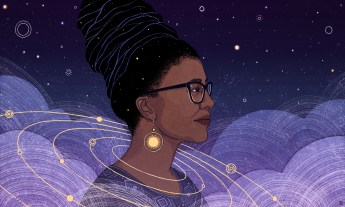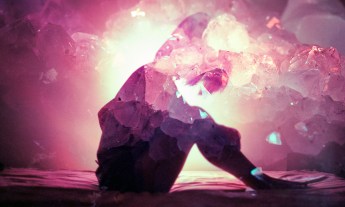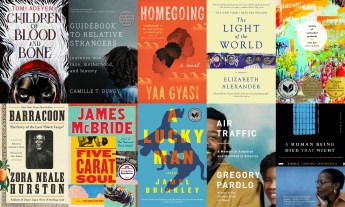
Being confined to a bed for months brought isolation and unspeakable pain, but it opened up Nnedi Okorafor’s mind to a universe of characters, ideas and stories.
Readers know Nnedi Okorafor as the author of acclaimed sci-fi novels including the Binti trilogy, the Akata series and Who Fears Death, as well as the writer of Marvel comics featuring Shuri, the Black Panther’s kid sister. Back in college, though, her focus was different — she was a track star and a budding entomologist. Scoliosis was a bump in her plan, and she underwent an operation that she was told would easily correct it.
But when Okorafor woke from surgery, she couldn’t move her legs. Confined to a hospital bed for months, unusual things happened. Bugs crawled the walls; strange dreams visited her. She began to put her experiences into writing, conjuring up strange, fantastical stories — and what she discovered during those days would prove to be the key to her life as a writer. Here, she recalls a pivotal moment from that hospital stay.
I awoke with a start, my throat clenching and unclenching, my stomach convulsing. My mind grabbed at its surroundings. The chair, the TV quietly playing soft music (Janet Jackson’s “That’s the Way Love Goes”), the sealed window. Oriented now, I began to settle, but the feeling of complete disgust lingered. My face was frozen in a grimace, though I wasn’t exactly sure why.
I’d been in the hospital for a week and a half now and this was the fourth time I’d awakened from a vivid, strange dream, gagging. I hated codeine. “It’s milder than morphine, but it can give some people bad dreams,” my father said when I’d asked him yesterday if codeine had hallucinatory effects. “Some people.” People like me.
Picking up a piece of blue clay, I began molding a long-legged woman. I used Popsicle sticks for her legs and rolled seven long thin chunks for her hair.
Because I couldn’t wheel myself very far into the hospital to visit with people my age, that afternoon I sat with young children as they did arts and crafts. Picking up a piece of blue clay, I began molding a long-legged woman. I used Popsicle sticks for her legs and rolled seven long thin chunks for her hair. In my mind, they were dreadlocks. Something told me to give her large breasts and I did this without question, knowing to trust and follow my creative process from the start. I hadn’t come up with a name for her yet but I knew it would be a name that Americans would find difficult to pronounce. I smiled, something I hadn’t done in a while.
The little boy beside me was making a truck and the little girl on my other side was just mashing the clay with her fist. The IV bag she carted around sat behind her, and I worried about the IV in her forearm falling out as she pounded. I liked being around these children. Their energy, no matter how depleted, was positive and shiny and sometimes I could talk smiles onto their faces. We had a lot in common. We liked to watch cartoons, play video games, and we were all incapacitated in some way.
Sitting up in the wheelchair was not easy to do for extended periods of time. It always grew uncomfortable, as it did now. But at least I had my clay lady. And she was special, I was sure of it. Knowing this somehow lessened the pain as I wheeled myself back to my room.
The pain medication would work for several hours, but then it ran out. The beast I’d come to know so well was squirming stealthily just beneath the surface.
But by the time I got there, I was gasping for breath, swallowing back screams of pain. The pain medication would work for several hours, but when it ran out, it was always sudden. The beast I’d come to know so well was squirming stealthily just beneath the surface. Watching, waiting, brooding behind a veil. Then when it got its chance, it broke through, teeth bared, claws out, breath of fire.
I grasped the doorknob with a quivering, sweaty hand. As I wheeled in, my toe hit the side of the door so hard my leg was nearly knocked from the footrest. I couldn’t focus my mind enough to worry about it. I pressed the call button for the nurses to help me into bed and fought to keep my spirit from fleeing my body to somewhere more peaceful.
Once on the bed, I sat there clutching the clay lady. The nurse said he’d be back with more pain medication, so in that moment, the beast of pain was wrapped tightly around my body and looking over my shoulder with a hot grin, its cold saliva dribbling down my shoulder onto my chest. I dumped the clay lady on top of the stack of books on the small shelf beside me.
I didn’t practice drawing cubes or cylinders. I drew letters and strung them together into words, then sentences, then a paragraph.
I reached for a book, just to distract myself from the pain, and hissed as the slight motion burst like fire along my back. I clutched the book and cracked it open. Over and over, I read the first few sentences, but I just couldn’t concentrate. The pain’s squeeze was fogging my senses. There was a pen on the shelf. A nurse must have left it there. I grabbed it. In high school, when the drone of certain teachers became unbearable I used to doodle. Focusing on the motion of the pen and the drawing of lines always pulled me out of my boredom, making me more able to listen to the teacher.
This time was different. I didn’t draw loops, swirls, crosses, or squiggles. I didn’t obsess over how closely I could draw lines around each other without letting them touch. I didn’t practice drawing three-dimensional cubes or cylinders. I drew letters and strung them together into words, then sentences, then a paragraph.
The sensation was like this:
A door opened, and with it came a warm breeze.
The breath of a beast. It was the sky.
There it was.
I grasped it.
My ancestors laughed.
Because finally, I’d found it.
If this woman I’d just created had the ability to fly, then that meant she could fly out of my hospital room whenever she wanted.
I drew the clay lady, except she actually wasn’t made of clay. She was flesh and bone, tall, with strange dreadlocks that crept down her back. She had a severe face. She wore a long blue dress, like something a nun would wear. It went all the way to her neck, down to her wrists, and was so long that it covered her big feet. She lived in a small village in Nigeria. A long time ago. I didn’t know how she wasn’t all sweaty in that dress. “Oh,” I said, as I scribbled all this around the edges of I, Robot. “I know why she’s not hot in that dress. Not all the time, at least.”
This woman could fly.
I looked up and blinked, realizing something. I still felt the pain, clutching me as tightly as ever, its weight pressing me down. It was so bad that I was squinting my eyes, tears were rolling down my face, my mouth hung open, and I was gripping the pen so hard that my double-jointed fingers bent in crazy directions. And yet, under that weight and compression, something in me aligned, focused, opened.
Reveling in this new sensation, I went back in … or should I say out? If this woman I’d just created had the ability to fly, then that meant she could fly out of my hospital room whenever she wanted.
“Legs? What do I need them for?” she’d say as she flew through my hospital room window, into the warm night sky on her way to wherever she wanted to go. I gazed from the words I’d scribbled to the clay lady and back to the words. I felt greater than myself. I felt myself become greater.
Excerpted from the new book Broken Places & Outer Spaces: Finding Creativity in the Unexpected by Nnedi Okorafor. Reprinted with permission from TED Books/Simon & Schuster. © 2019 Nnedi Okorafor.
Read about Okorafor’s creative process in the TED Ideas story: “Write your story, and don’t be afraid to write it” — a sci-fi writer talks about finding her voice and being a superhero
Watch her TED Talk now: https://www.ted.com/talks/nnedi_okorafor_sci_fi_stories_that_imagine_a_future_africa?language=en











